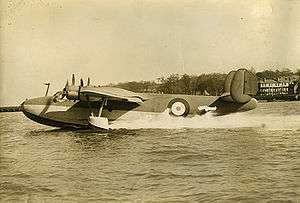Saro Shrimp
The Saunders Roe A.37 Shrimp was a 1930s British two-seat four-engined experimental flying boat built by Saunders-Roe Limited ("Saro") at Cowes.
| A.37 Shrimp | |
|---|---|
 | |
| Role | research aircraft |
| Manufacturer | Saunders-Roe Limited |
| Designer | H Knowler |
| First flight | October 1939 |
| Introduction | 1939 |
| Retired | 1949 |
| Status | Scrapped |
| Primary users | Saunders Roe Air Ministry |
| Number built | 1 |
Development
The Shrimp was designed by H Knowler in 1939 as a half-size research aircraft as part of a development programme for the Saunders-Roe S.38 a four-engined patrol flying-boat to Specification R.5/39 – a replacement for the Short Sunderland.[1] The R.5/39 project was cancelled but the Shrimp was completed as a private venture. Registered as G-AFZS, it was first flown at Cowes in October 1939. It was based at Beaumaris, Anglesey where a slipway was built for it. The Ministry of Aircraft Production acquired it in 1944 with the serial TK580 for tests to help the design of the Short Shetland a successor to the R.5/39 project being developed jointly by Saro and Short Brothers. For this its twin rudder tail was swapped for a single fin and the hull was modified to represent that of the Shetland.[2]
The Shrimp was scrapped at Felixstowe in 1949.
Specifications
Data from Warplanes of the Second World War, Volume 5: Flying Boats[3]
General characteristics
- Crew: 2
- Length: 43 ft 3 1⁄4 in (13.189 m)
- Wingspan: 50 ft 0 in (15.24 m)
- Height: 12 ft 8 3⁄4 in (3.880 m)
- Wing area: 340 sq ft (32 m2)
- Empty weight: 4,362 lb (1,979 kg)
- Gross weight: 5,700 lb (2,585 kg)
- Max takeoff weight: 6,200 lb (2,812 kg)
- Powerplant: 4 × Pobjoy Niagara III 7-cylinder air-cooled geared radial piston engines, 95 hp (71 kW) each
- Propellers: 2-bladed fixed-pitch propellers
Performance
- Maximum speed: 130 mph (210 km/h, 110 kn)
- Endurance: 3 hours
- Rate of climb: 635 ft/min (3.23 m/s)
- Wing loading: 16.8 lb/sq ft (82 kg/m2)
References
- Notes
- Jarrett 1991, p.146.
- Jarrett 1991, p.148.
- Green 1972, p. 90.
- Bibliography
- Green, William. Warplanes of the Second World War, Volume 5: Flying Boats. London: Macdonald & Company (Publishers) Ltd., 1962 (5th Impression 1972). ISBN 0-356-01449-5.
- Jackson, A.J. British Civil Aircraft since 1919. London: Putnam & Company, 1974. ISBN 0-370-10014-X.
- Jarrett, Philip. "Nothing Ventured...No 12". Aeroplane Monthly, March 1991, Vol 19 No, 3 Issue 215. ISSN 0143-7240. pp. 146–150.
- London, Peter. Saunders and Saro Aircraft Since 1917. London: Putnam (Conway Maritime Press), London, 1988. ISBN 0-85177-814-3.
- The Illustrated Encyclopedia of Aircraft (Part Work 1982–1985). Orbis Publishing.
External links
| Wikimedia Commons has media related to Saro Shrimp. |
- Saro A.37 – British Aircraft Directory
- Saro A.37 – British aircraft of World War II
- "Dynamic Similarity" a 1940 Flight article